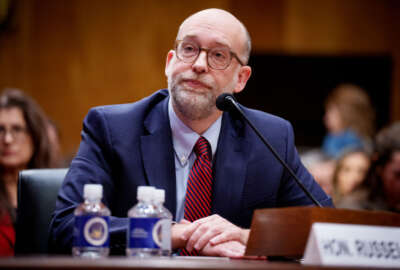Amid political leadership vacancies, calls for SES reform continue to rise
Opting for career SES officials or appointees who don’t need Senate confirmation may be the most effective way to minimize persistent leadership vacancies.
Challenges in the Senate confirmation process are leading to persistent leadership vacancies across government — and the problem is getting worse.
Research from the Partnership for Public Service, published earlier this month, found that the Senate confirmation process has taken almost three times as long for President Joe Biden’s nominees, compared with nominations made decades ago during the George H.W. Bush administration.
With the slowing confirmation process, many senior leadership seats in the executive branch are often left without a permanent official. In some cases, agencies may wait to take actions in the absence of permanent leadership, the Partnership said. But in many other instances, career members of the Senior Executive Service (SES) step up to the task in an acting capacity.
The frequent use of career SES members to temporarily fill in on political vacancies indicates there are many cases where a career leader in government may be a better choice in the first place. The Partnership said reducing the number of Senate-confirmed positions and instead opting for either career agency officials, or appointees who don’t need a Senate confirmation, would be the most effective route forward for minimizing vacancies.
“To address the vacancy crisis, Congress should review whether to remove the requirement of Senate confirmation for the persistently vacant positions,” the Partnership wrote. “While some of these roles are best performed by an appointee of the president due to their close connection to policymaking, many could be better served by the consistent leadership of a member of the Senior Executive Service.”
Marcus Hill, president of the Senior Executives Association (SEA), said career SES members working in leadership roles often benefit from the institutional knowledge they have of the agency they work for.
“Whether appointed roles are unfilled due to a lag in the nomination by an administration, delayed action by the Senate or gaps given a second term or presidential transition scenario, career federal executives have proven that they are ready and able to step up and into agency leadership positions,” Hill wrote in a press release Tuesday. “Career senior executives provide stability in administration and enable presidents to faithfully execute the law. They also provide important institutional memory and expertise on how best to implement priorities for new appointees of any administration.”
But as SES members continue to fill in on the work of empty political leadership roles, SEA said there are major needs for reform to the SES as an institution. Jason Briefel, SEA’s director of policy and outreach, said when considering reforms for political appointees and career SES members, it’s not an “either-or” situation.
“When you talk about vacancies of appointees, and the challenges and the implications of that, it’s important to think about the other side of that coin,” Briefel said in an interview. “Who is standing in the breach? What are we doing to support them? How do we make that part of the process work?”
SEA has said the risks of joining the SES often outweigh its rewards, which may disincentivize otherwise qualified candidates from applying for the senior-level positions.
For instance, some career SES members experience a phenomenon called “pay compression” due to statutory limits placed on their pay raises each year. Whether an individual is affected depends on their exact level and their geographic location, but generally, the pay compression has worsened over time.
To address the issue, SEA has called for decoupling the pay system from the Executive Schedule, which would remove the current pay ceiling.
Reforming SES assessments
In addition to addressing pay issues, many good government organizations have urged the Office of Personnel Management to reform the assessments that SES applicants must complete to be considered for a position.
To apply for an SES position, applicants have to answer questions on how they meet “executive core qualifications” (ECQs), which OPM first defined years ago. But often, the content of the ECQs doesn’t align with the actual qualifications or duties of an SES position, said Terry Gerton, president and CEO of the National Academy of Public Administration (NAPA).
“When you talk to the real person who might make it through to the interview, it almost has no connection to what they’re going to do on the job,” Gerton said during a GovExec event earlier this month.
Calvin Byrd, a former Nuclear Regulatory Commission senior executive, added that many applicants for SES positions find the process of writing ECQs “overwhelming.”
“Another major concern is the long waiting period before placement — it may take several months,” Byrd said. “As a result, it’s often difficult to get the best and the brightest to apply.”
In its press release Tuesday, SEA referenced a call it first made in 2018, alongside the Partnership and the Volcker Alliance, for a modernized federal workforce. Part of the coalition’s joint policy agenda, at the time, urged OPM to reexamine the SES application and assessment processes, including relooking at ECQs. To date, those recommendations have not been implemented.
But now, there may be some changes coming sooner rather than later for the SES evaluation process. Biden’s 2023 executive order on AI tasked OPM with revisiting and implementing new ECQs for SES roles that are “informed by data and AI literacy competencies,” the order states.
“The intersection between AI and the ECQs is great, because if that hadn’t happened, who knows how long it might have been until this update happened?” Briefel said. “Hopefully we can adopt that tech-infused mindset to keep going faster and figure out how we can do some sprints on some of these things and knock them out.”
Agencies also have an opportunity right now to consider the senior leadership they’ll need for the next couple years. OPM is currently asking agencies to submit requests for the numbers of SES members, as well as Senior Level (SL) and Scientific and Professional (ST), they think they’ll need during fiscal 2026 and 2027.
“OPM expects agencies to be judicious in making requests for additional allocations,” Veronica Hinton, OPM’s associate director of workforce policy and innovation, wrote in a July memo. “In determining the number of allocations to request, agencies should complete a comprehensive, agencywide assessment of current and prospective executive resources needs and consider mission priorities.”
OPM set an upcoming deadline of Aug. 23 for agencies to submit those requests.
Copyright © 2025 Federal News Network. All rights reserved. This website is not intended for users located within the European Economic Area.
Drew Friedman is a workforce, pay and benefits reporter for Federal News Network.
Follow @dfriedmanWFED






